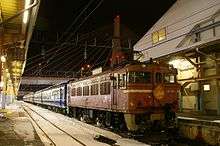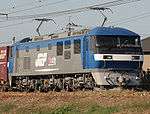JNR Class ED79
|
JR Hokkaido ED79 19 on a Kaikyo service in 1992 | |||||||||||||||||||||||||
| |||||||||||||||||||||||||
| |||||||||||||||||||||||||
| |||||||||||||||||||||||||
| |||||||||||||||||||||||||
The Class ED79 (ED79形) is a Bo-Bo wheel arrangement AC electric locomotive type operated on passenger and freight services in the north of Japan since 1986, originally by Japanese National Railways (JNR), and later by Hokkaido Railway Company (JR Hokkaido) and Japan Freight Railway Company (JR Freight).[1]
Variants
- ED79-0: Numbers ED79-1 – 21 (converted from ED75-700, 1986-1987)
- ED79-50: Numbers ED79-51 – 60 (built from new)
- ED79-100: Number ED79-101 – 113 (converted from ED75-700, 1986-1987)
ED79-0
21 Class ED79-0 locomotives were converted between 1986 and 1987 at JNR's Omiya, Tsuchizaki, and Naebo Workshops from former Class ED75-700 locomotives to haul both freight and passenger trains through the undersea Seikan Tunnel between the main island of Honshu and the northern island of Hokkaido, which opened in March 1988.[1] The gear ratio was reduced from the 4.44 of the original ED75 locomotives to 3.38, giving a top speed of 110 km/h (70 mph) better suited to express passenger and freight workings.[1] With the privatization of JNR on 1 April 1987, all 21 locomotives were transferred to the ownership of JR Hokkaido.[2]
Daytime Kaikyo services previously hauled by Class ED79 locomotives between Aomori and Hakodate through the Seikan Tunnel were discontinued in 2002, replaced by the Hakucho and Super Hakucho limited express services using electric multiple unit (EMU) trains).[2] In 2006, the Nihonkai sleeping car service no longer ran through the tunnel, and JR Freight also ceased using JR Hokkaido locomotives on freight services, due to the increased availability of Class EH500 locomotives.[2]
As of 1 April 2013, nine Class ED79-0 locomotives remain in service, owned by JR Hokkaido and based at Hakodate Depot.[3] These are used to haul the Cassiopeia, Hokutosei, Twilight Express, and Hamanasu overnight services between Aomori and Hakodate via the Seikan Tunnel.[2]
 ED79 1 on a Hamanasu service, January 2005
ED79 1 on a Hamanasu service, January 2005 ED79 8 at Hakodate Station after arriving on a Hokutosei overnight sleeping car service, July 2004
ED79 8 at Hakodate Station after arriving on a Hokutosei overnight sleeping car service, July 2004
The fleet details are shown below.[3][4]
| Number | Converted from | Withdrawn |
|---|---|---|
| ED79 1 | ED75 765 | 24 March 2009 |
| ED79 2 | ED75 772 | 18 March 2005 |
| ED79 3 | ED75 773 | 31 March 2003 |
| ED79 4 | ED75 774 | |
| ED79 5 | ED75 776 | 1 July 2005 |
| ED79 6 | ED75 782 | 31 October 2003 |
| ED79 7 | ED75 763 | |
| ED79 8 | ED75 778 | 10 February 2006 |
| ED79 9 | ED75 779 | |
| ED79 10 | ED75 780 | 31 October 2012 |
| ED79 11 | ED75 781 | |
| ED79 12 | ED75 784 | |
| ED79 13 | ED75 785 | |
| ED79 14 | ED75 786 | |
| ED79 15 | ED75 787 | 30 April 2008 |
| ED79 16 | ED75 788 | 27 September 2004 |
| ED79 17 | ED75 789 | 10 February 2006 |
| ED79 18 | ED75 790 | |
| ED79 19 | ED75 791 | 30 April 2008 |
| ED79 20 | ED75 760 | |
| ED79 21 | ED75 783 | 25 August 2003 |
Special liveries

From February 2000, eight locomotives (numbers 3, 8, 10, 11, 14, 17, 19, and 21) received differing Doraemon liveries.[5]
ED79-50
10 Class ED79-50 locomotives were built between 1989 and 1990 by Toshiba for JR Freight for use on freight services through the Seikan Tunnel.[1] These locos were finished from new in the then-new JR Freight livery of pale purple and two-tone blue, with maroon ("Red No. 2")[4] cab doors.[1]
As of 1 April 2013, nine out of the original ten Class ED79-50 locomotives remain in service, owned by JR Freight and based at Goryokaku Depot.[3] These are normally used in pairs to haul freight services between Higashi-Aomori and Goryokaku via the Seikan Tunnel.[2]
- ED79 60 in February 2010
- ED79 58/51 on a freight service in September 2009
The withdrawal dates for the fleet are shown below.[3]
| Number | Delivered | Withdrawn |
|---|---|---|
| ED79 51 | - | |
| ED79 52 | - | |
| ED79 53 | - | |
| ED79 54 | - | |
| ED79 55 | - | |
| ED79 56 | - | 24 March 2000 |
| ED79 57 | - | |
| ED79 58 | - | |
| ED79 59 | - | |
| ED79 60 | - |
ED79-100
13 Class ED79-100 locomotives were converted between 1986 and 1987 at JNR's Omiya, Tsuchizaki, and Naebo Workshops from former Class ED75-700 locomotives.[1] As with the ED79-0 subclass, these were intended to haul freight and passenger trains through the undersea Seikan Tunnel between Honshu and Hokkaido, but as a cost-saving measure, only one cab end was equipped with the necessary ATC equipment, so these locomotives were only able to operate in multiple with an ED79-0 locomotive and were not permitted to run singly through the tunnel.[1] An ED79-100 locomotive would be coupled at the northern end of an ED75-0.[1]
With the privatization of JNR on 1 April 1987, all 13 locomotives were transferred to the ownership of JR Hokkaido, although they were also loaned for use on JR Freight services until 2006.[2] The last remaining member of the sub-class was withdrawn in March 2009.[2]
 ED79 106 and ED79 10 in 1991
ED79 106 and ED79 10 in 1991
The fleet details are shown below.[3][4]
| Number | Converted from | Withdrawn |
|---|---|---|
| ED79 101 | ED75 769 | 25 August 2003 |
| ED79 102 | ED75 718 | 31 March 2003 |
| ED79 103 | ED75 717 | 31 March 2001 |
| ED79 104 | ED75 720 | 24 March 2009 |
| ED79 105 | ED75 761 | 12 September 2002 |
| ED79 106 | ED75 728 | 28 December 2004 |
| ED79 107 | ED75 719 | 24 March 2009 |
| ED79 108 | ED75 724 | 24 March 2009 |
| ED79 109 | ED75 709 | 31 August 2003 |
| ED79 110 | ED75 732 | 10 February 2006 |
| ED79 111 | ED75 731 | 12 September 2002 |
| ED79 112 | ED75 738 | 27 September 2004 |
| ED79 113 | ED75 737 | 15 November 2001 |
See also
References
- 1 2 3 4 5 6 7 8 JR全車輛ハンドブック'92 [JR Rolling Stock Handbook 1992]. Japan: Neko Publishing. 1992. pp. 41–42.
- 1 2 3 4 5 6 7 JR機関車カタログ [JR Locomotive Catalogue]. Japan: Ikaros Publications Ltd. 20 June 2013. pp. 60–62. ISBN 9784863207271.
- 1 2 3 4 5 JR気動車客車編成表 2013 [JR DMU & Coaching Stock Formations - 2013]. Japan: JRR. 30 June 2013. p. 143. ISBN 978-4-330-37813-8.
- 1 2 3 ELダイヤ情報21 [Electric Loco Timetable Information 21]. Tokyo, Japan: Kotsu Shimbunsha. October 2012. pp. 42–43. ISBN 978-4330320120.
- ↑ さらば青函特急 [Farewell Seikan Limited Expresses]. Japan Railfan Magazine (in Japanese). Vol. 56 no. 658. Japan: Koyusha Co., Ltd. February 2016. p. 37.
| Wikimedia Commons has media related to JNR ED79. |

